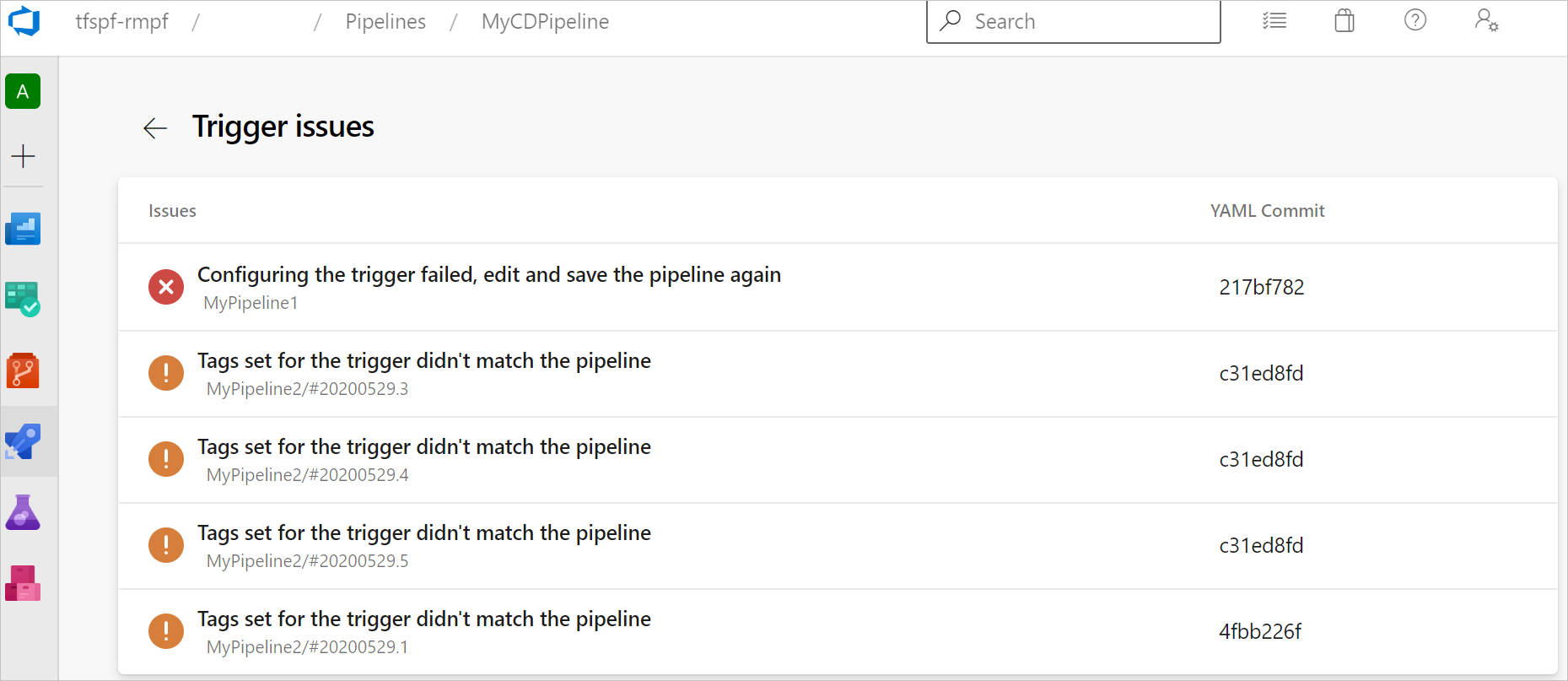Note
Access to this page requires authorization. You can try signing in or changing directories.
Access to this page requires authorization. You can try changing directories.
Azure DevOps Services | Azure DevOps Server 2022 - Azure DevOps Server 2019
This article discusses resources for YAML pipelines. A resource is anything a pipeline uses that exists outside that pipeline. Resources in YAML pipelines can be other pipelines, builds, containers, packages, repositories, or webhooks.
After you define a resource, you can consume it anywhere in your pipeline. For more information and examples, see Resource definitions.
resources:
pipelines:
- pipeline: resources1
source: otherPipeline
steps:
- download: resources1
artifact: artifact1.txt
You can use resource status to automatically trigger pipelines by setting the trigger property in the resource definition. The pipeline resources.triggeringAlias and resources.triggeringCategory variables are then set to the resource name and category. These variables are empty unless the Build.Reason variable is set to ResourceTrigger.
Resources allow full traceability for the services a pipeline uses, including version, artifacts, associated commits, and work items. If you subscribe to trigger events on your resources, you can fully automate your DevOps workflows.
Note
This article primarily discusses resources in YAML pipelines. For resources in Classic pipelines, see About resources for Azure Pipelines.
Resource authorization
Resources must be authorized to be used in pipelines. Resource owners control the users and pipelines that can access their resources. There are several ways to authorize a YAML pipeline to use resources.
Use the resource's administration settings to Grant access permissions to all pipelines. For example, you can manage secure files and variable groups on the Pipelines > Library page, and agent pools and service connections in Project settings > Pipelines. This authorization is convenient for resources you don't need to restrict, such as test resources.
Make sure you have at least User role in the agent pool security roles for your project. YAML pipelines you create are automatically authorized to use resources where you have User role.
If you add a resource definition to a YAML pipeline but the build fails with an error like
Could not find a <resource> with name <resource-name>. The <resource> does not exist or has not been authorized for use, make sure you have at least User role on the resource. You can then choose the option to authorize the resources on the failed build. Once the resource is authorized, you can start a new build.
Approval checks for resources
You can use approval checks and templates to manually control resource use. By using the required template approval check, you can require any pipeline that uses a certain resource or environment to extend from a specific YAML template.
Setting a required template approval enhances security by ensuring that your resource is used only under specific conditions. For more information, see Use templates for security.
Manual resource version picker
Azure Pipelines evaluates the default versions for resources based on their resource definitions. For scheduled runs, or manual runs if you don't manually choose a run, Azure Pipelines considers only successfully completed continuous integration (CI) runs to evaluate default resource versions.
You can use the manual resource version picker to choose different resource versions when you manually trigger a YAML continuous deployment (CD) pipeline. The resource version picker is supported for pipeline, build, repository, container, and package resources.
For pipeline resources, the manual version picker lets you see all available runs across all branches, search the runs based on the pipeline number or branch, and pick a run that's successful, failed, or in progress.
You don't need to wait for a CI run to complete, or rerun it because of an unrelated failure, before you can run your CD pipeline. You have the flexibility to choose any run that you know produced the artifacts you need.
To use the resource version picker, select Resources in the Run pipeline pane, select a resource, and pick a specific version from the list of available versions. For resources where you can't fetch available versions, like GitHub packages, you can enter your desired version in the text field.
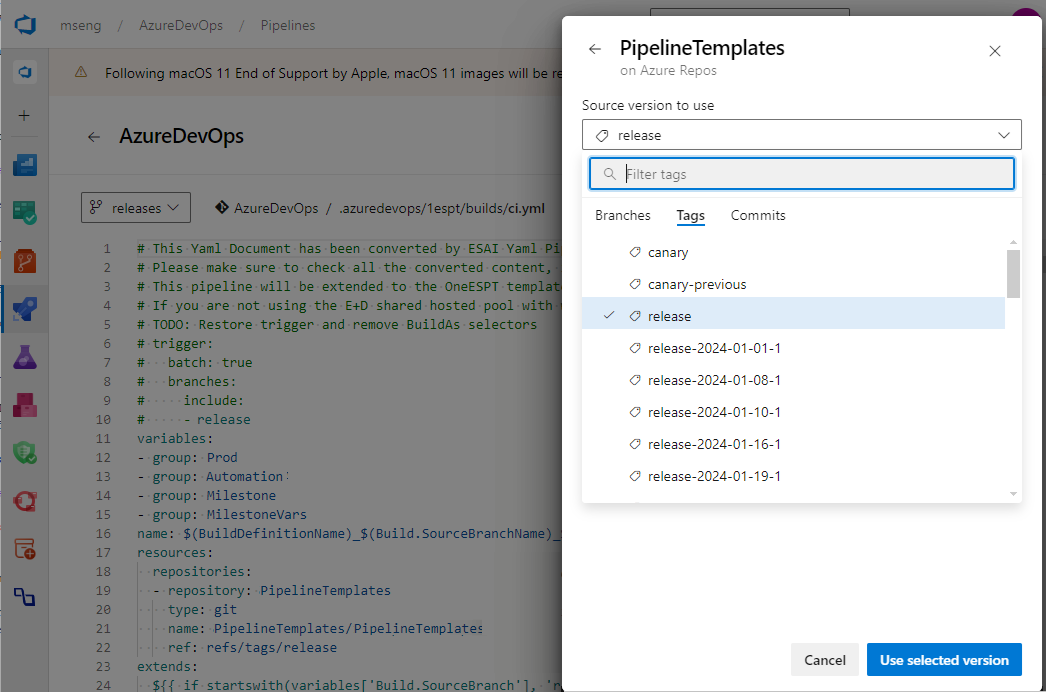
Resource definitions
YAML pipeline resources can be:
The following sections provide definitions and examples of the YAML pipeline resource categories. For complete schema information, see the resources definition in the YAML schema reference for Azure Pipelines.
Pipelines resource
You can use CI pipeline resources as triggers for your CD workflows. You can also reference pipeline resources from your pipeline to download artifacts or use pipeline resource variables. Only Azure Pipelines can use the pipelines resource.
In the pipelines resource definition:
pipelineis a unique name you use to reference the pipeline resources.sourceis the name of the pipeline that produced the pipeline artifacts.
For complete schema information, see the resources.pipelines.pipeline definition.
Example pipeline resource definitions
The following example resource definition consumes artifacts from a pipeline within the same Azure DevOps project.
resources:
pipelines:
- pipeline: SmartHotel-resource # identifier to use in pipeline resource variables
source: SmartHotel-CI # name of the pipeline that produces the artifacts
To specify a pipeline from another project, include the project name in the resource definition. The following example also uses branch to resolve the default version when the pipeline is triggered manually or by schedule. The branch input can't have wildcards.
resources:
pipelines:
- pipeline: SmartHotel
project: otherDevOpsProject
source: SmartHotel-CI
branch: releases/M142
Resource version evaluation
Azure Pipelines evaluates the default versions for resources based on their resource definitions. A pipeline's default resource artifact versions depend on whether the pipeline runs manually or on schedule, or triggers based on the outcome of the resource run.
For a manual or scheduled pipeline run, the values of the version, branch, and tags properties in the pipeline resource definition define the artifact versions. The branch input can't have wildcards, and the tags properties use the AND operator.
For scheduled runs, or manual runs if you don't use the version picker, Azure Pipelines considers only successfully completed continuous integration (CI) runs when evaluating default resource versions. For manual runs, you can override the defined versions by using the manual version picker.
The following table lists pipeline resource definition properties and the artifact versions they specify.
| Specified property | Artifact version |
|---|---|
version |
Build that has the specified run number |
branch |
Latest build that ran on the specified branch |
tags |
Latest build that has all the specified tags |
branch and tags |
Latest build run on the specified branch that has all the specified tags |
version and branch |
Build with the specified run number and the specified branch |
| None | Latest build across all branches |
The following pipeline resource definition uses the branch and tags properties to evaluate the default version when the pipeline is scheduled or triggered manually. The myCIAlias artifacts version is the latest build run on the main branch that has the Production and PreProduction tags.
resources:
pipelines:
- pipeline: myCIAlias
project: Fabrikam
source: Fabrikam-CI
branch: main
tags:
- Production
- PreProduction
Pipeline resource triggers
For pipeline runs that trigger on the outcome of a resource run, the trigger property settings in the resource definition determine the default resource artifact versions. To use a pipeline resource as a trigger to run the current pipeline, you must set the trigger property. If you don't include a trigger property, resource runs don't trigger current pipeline runs.
When a pipeline triggers based on a trigger value in a pipeline resource definition, the values of the overall resource definition version, branch, and tags properties are ignored. The trigger properties determine the artifact versions.
Important
When you define a pipeline resource trigger:
- If the
pipelineresource is from the same repository as the current pipeline, orself, triggering is on the same branch and commit that raises the triggering event. - If the
pipelineresource is from a different repository than the current pipeline, triggering is on the default branch of thepipelineresource repository.
The following table describes how the trigger properties affect trigger behavior.
| Trigger property | Trigger behavior |
|---|---|
true |
Triggering occurs when the resource pipeline successfully completes a run. |
branches |
Triggering occurs when the resource pipeline successfully completes a run on one of the include branches. |
tags |
Triggering occurs when the resource pipeline successfully completes a run tagged with all of the specified tags. |
stages |
Triggering occurs when the resource pipeline successfully runs the specified stages. |
branches, tags, and stages |
Triggering occurs when the successful resource pipeline run satisfies all branch, tag, and stage conditions. |
The following example shows a pipelines resource definition with a simple trigger.
resources:
pipelines:
- pipeline: SmartHotel
project: otherDevOpsProject
source: SmartHotel-CI
trigger: true
The following example shows a pipeline resource trigger with branch conditions.
resources:
pipelines:
- pipeline: SmartHotel
project: otherDevOpsProject
source: SmartHotel-CI
trigger:
branches:
- releases/*
- resources.triggeringAlias
The following example uses stages filters to evaluate trigger conditions for CD pipelines. Trigger stages use the AND operator. The CD pipeline triggers upon successful completion of all the listed stages.
resources:
pipelines:
- pipeline: MyCIAlias
project: Fabrikam
source: Fabrikam-CI
trigger:
stages:
- PreProduction
- Production
The following example uses tags filters for default version evaluation and for the trigger. The trigger tags use the AND operator. The tags set in pipeline resource definitions are different from the tags set on branches in the Git repository.
resources:
pipelines:
- pipeline: MyCIAlias
project: Fabrikam
source: Fabrikam-CI
tags:
- Production
trigger:
tags:
- Production
- Signed
The following pipeline runs whenever the SmartHotel-CI resource pipeline:
- Runs on one of the
releasesbranches or on themainbranch. - Is tagged with both
VerifiedandSigned. - Completes both the
ProductionandPreProductionstages.
resources:
pipelines:
- pipeline: SmartHotel
project: otherDevOpsProject
source: SmartHotel-CI
trigger:
branches:
include:
- releases/*
- main
exclude:
- topic/*
tags:
- Verified
- Signed
stages:
- Production
- PreProduction
Pipeline artifact download
You can use the download step in a YAML pipeline to download artifacts associated with the current run or with another pipeline resource.
Artifacts download automatically only in deployment jobs. All artifacts from the current pipeline and all its pipeline resources automatically download and are available at the beginning of each deployment job. You can override this behavior by setting download to none, or by specifying another pipeline resource identifier.
In a regular build job, artifacts don't automatically download. Use download explicitly when needed.
In the download step, the optional artifact property specifies artifact names. If not specified, all available artifacts download.
The optional patterns property defines patterns that represent files to download. For full schema information, see the steps.download definition.
- job: deploy_windows_x86_agent
steps:
- download: SmartHotel
artifact: WebTier1
patterns: '**/*.zip'
Artifacts from the pipeline resource download to the $(PIPELINE.WORKSPACE)/<pipeline-identifier>/<artifact-identifier> folder. For more information, see Publish and download pipeline artifacts. For an alternative way to download pipeline artifacts, see Download artifacts.
Pipeline resource variables
The metadata for a pipeline resource is available to all jobs in each run as predefined variables. These variables are available to your pipeline only at runtime, and therefore can't be used in template expressions, which are evaluated at pipeline compile time.
For more information, see Define variables and Pipeline resource metadata as predefined variables.
The following example returns the predefined variable values for the myresourcevars pipeline resource.
resources:
pipelines:
- pipeline: myresourcevars
source: mypipeline
trigger: true
steps:
- script: |
echo $(resources.pipeline.myresourcevars.pipelineID)
echo $(resources.pipeline.myresourcevars.runName)
echo $(resources.pipeline.myresourcevars.runID)
echo $(resources.pipeline.myresourcevars.runURI)
echo $(resources.pipeline.myresourcevars.sourceBranch)
echo $(resources.pipeline.myresourcevars.sourceCommit)
echo $(resources.pipeline.myresourcevars.sourceProvider)
echo $(resources.pipeline.myresourcevars.requestedFor)
echo $(resources.pipeline.myresourcevars.requestedForID)
Builds resource
If you have a CI build system that produces artifacts, you can consume the artifacts with builds resources.
The builds category is extensible. A build resource can be from any external CI system like Jenkins, TeamCity, or CircleCI. You can use builds to write an extension to consume artifacts from your build service or introduce a new type of service.
In the build definition, version defaults to the latest successful build. You must explicitly set trigger if desired. For complete schema information, see the resources.builds.build definition.
In the following example, Jenkins is the resource type.
resources:
builds:
- build: Spaceworkz
type: Jenkins
connection: MyJenkinsServer
source: SpaceworkzProj # name of the Jenkins source project
trigger: true
Important
Triggers are supported for hosted Jenkins only where Azure DevOps has line of sight with the Jenkins server.
The downloadBuild task
The build resource artifacts don't automatically download to jobs/deploy-jobs. To consume artifacts from the build resource as part of your jobs, you need to explicitly add the downloadBuild task. You can customize the download behavior for each deployment or job.
The downloadBuild task automatically resolves to the corresponding download task for the type of build resource the runtime defines. Artifacts from the build resource download to the $(PIPELINE.WORKSPACE)/<build-identifier>/ folder.
In the downloadBuild definition, you specify the resource to download artifacts from. The optional artifact property specifies artifacts to download. If not specified, all artifacts associated with the resource download.
The optional patterns property defines a minimatch path or list of minimatch paths to download. If blank, the entire artifact downloads. The following example downloads only the *.zip files.
- job: deploy_windows_x86_agent
steps:
- downloadBuild: Spaceworkz
patterns: '**/*.zip'
For complete schema information, see the steps.downloadBuild definition.
Repositories resource
Use the repository keyword to let the system know about external repositories if:
- Your pipeline has templates in another repository.
- You want to use multi-repo checkout with a repository that requires a service connection.
For example:
resources:
repositories:
- repository: common
type: github
name: Contoso/CommonTools
endpoint: MyContosoServiceConnection
For complete schema information, see the resources.repositories.repository definition.
Repository resource types
Azure Pipelines supports the git, github, githubenterprise, and bitbucket repository types.
- The
gittype refers to Azure Repos Git repos. - GitHub Enterprise repos require a GitHub Enterprise service connection for authorization.
- Bitbucket Cloud repos require a Bitbucket Cloud service connection for authorization.
The following table describes the repository resource types:
| Type | Name value | Example |
|---|---|---|
git |
A different repository in the same project or same organization. | Same project: name: otherRepoAnother project in the same organization: name: otherProject/otherRepo. |
github |
Full name of the GitHub repository including the user or organization. | name: myOrganization/otherRepo |
githubenterprise |
Full name of the GitHub Enterprise repository including the user or organization. | name: myEnterpriseOrg/otherRepo |
bitbucket |
Full name of the Bitbucket Cloud repository including the user or organization. | name: MyBitbucketOrg/otherRepo |
Repository resource variables
The metadata for a repository resource is available to all jobs in every run as runtime variables. The <alias> is the repository identifier from your repository resource definition.
resources.repositories.<alias>.name
resources.repositories.<alias>.ref
resources.repositories.<alias>.type
resources.repositories.<alias>.id
resources.repositories.<alias>.url
The following repository resource definition has an alias of common, so you access the repository resource variables using resources.repositories.common.*.
resources:
repositories:
- repository: common
type: git
ref: main
name: repo
variables:
ref: $[ resources.repositories.common.ref ]
name: $[ resources.repositories.common.name ]
id: $[ resources.repositories.common.id ]
type: $[ resources.repositories.common.type ]
url: $[ resources.repositories.common.url ]
steps:
- bash: |
echo "name = $(name)"
echo "ref = $(ref)"
echo "id = $(id)"
echo "type = $(type)"
echo "url = $(url)"
The metadata for a repository resource is available to all jobs in every run as runtime variables. The <alias> is the repository identifier from your repository resource definition.
resources.repositories.<alias>.name
resources.repositories.<alias>.ref
resources.repositories.<alias>.type
resources.repositories.<alias>.id
resources.repositories.<alias>.url
resources.repositories.<alias>.version
The following example has an alias of common, so you access the repository resource variables using resources.repositories.common.*.
resources:
repositories:
- repository: common
type: git
ref: main
name: Repo
variables:
ref: $[ resources.repositories.common.ref ]
name: $[ resources.repositories.common.name ]
id: $[ resources.repositories.common.id ]
type: $[ resources.repositories.common.type ]
url: $[ resources.repositories.common.url ]
version: $[ resources.repositories.common.version ]
steps:
- bash: |
echo "name = $(name)"
echo "ref = $(ref)"
echo "id = $(id)"
echo "type = $(type)"
echo "url = $(url)"
echo "version = $(version)"
Checkout keyword for repositories
Repos from the repository resource aren't automatically synced in your jobs. You can use the checkout keyword to fetch a repository defined in a repository resource. For more information, see Check out multiple repositories in your pipeline. For complete schema information, see the steps.checkout definition.
Containers resource
You can use containers resources to consume container images in your CI/CD pipelines. A container resource can be a public or private Docker registry or an Azure Container Registry instance.
You can consume a generic container resource image as part of your jobs, or use it in container jobs. If your pipeline requires the support of one or more services, you also need to create and connect to service containers. You can use volumes to share data between services.
If you need to consume images from a Docker registry, you can define a generic container resource without using a type keyword. For example:
resources:
containers:
- container: smartHotel
endpoint: myDockerRegistry
image: smartHotelApp
For complete schema information, see the resources.containers.container definition.
Note
The enabled: 'true' syntax to enable container triggers for image tags is different from the syntax for other resource triggers. Be sure to use the correct syntax for specific resources.
Azure Container Registry resource type
To consume your Azure Container Registry images, you can use the first-class container resource type acr. You can use this resource type in your jobs and to enable automatic pipeline triggers.
You need Azure Container Registry Contributor or Owner permissions to use automatic pipeline triggers. For more information, see Azure Container Registry roles and permissions.
To use the acr resource type, you must specify the azureSubscription, resourceGroup, and repository values for your Azure container registry. For example:
resources:
containers:
- container: petStore
type: acr
azureSubscription: ContosoConnection
resourceGroup: ContosoGroup
registry: petStoreRegistry
repository: myPets
trigger:
tags:
include:
- production*
Note
Trigger evaluation occurs only on the default branch. Make sure to set the correct default branch or merge the YAML file into the current default branch. For more information on how to change the pipeline default branch, see Pipeline default branch.
Container resource variables
Once you define a container as a resource, container image metadata passes to the pipeline as variables. Information like image, registry, and connection details are accessible across all the jobs used in your container deployment tasks.
Container resource variables work with Docker and Azure Container Registry. You can't use container resource variables for local image containers. The location variable applies only to the acr container resource type.
The following example has an Azure Resource Manager service connection named arm-connection. For more information, see Azure container registries, repositories, and images.
resources:
containers:
- container: mycontainer
type: acr
azureSubscription: arm-connection
resourceGroup: rg-storage-eastus
registry: mycontainerregistry
repository: hello-world
trigger:
tags:
- latest
steps:
- script: echo |
echo $(resources.container.mycontainer.type)
echo $(resources.container.mycontainer.registry)
echo $(resources.container.mycontainer.repository)
echo $(resources.container.mycontainer.tag)
echo $(resources.container.mycontainer.digest)
echo $(resources.container.mycontainer.URI)
echo $(resources.container.mycontainer.location)
Packages resource
You can consume NuGet and npm GitHub packages as resources in YAML pipelines. To enable automated pipeline triggers when a new package version releases, set the trigger property to true.
When you define package resources, specify the package <repository>\<name> in the name property, and set the package type as NuGet or npm. To use GitHub packages, use personal access token (PAT)-based authentication and create a GitHub service connection that uses the PAT.
For complete schema information, see the resources.packages.package definition.
Packages aren't automatically downloaded into jobs by default. To download, use getPackage.
The following example has a GitHub service connection named pat-contoso to a GitHub npm package named contoso. For more information, see GitHub packages.
resources:
packages:
- package: contoso
type: npm
connection: pat-contoso
name: myname/contoso
version: 7.130.88
trigger: true
steps:
- getPackage: contoso
Webhooks resource
Note
Webhooks released in Azure DevOps Server 2020.1.
You can use Azure Pipelines pipeline, container, build, and package resources to consume artifacts and automate triggers, but you can't use them to base deployments on external events or services. Webhooks automate your workflow based on external webhook events that first-class Azure Pipelines resources don't support. You can subscribe to external events through webhooks and use the events to trigger your pipelines.
The webhooks resource in YAML pipelines lets you integrate your pipelines with external services like GitHub, GitHub Enterprise, Nexus, and Artifactory to automate workflows. For on-premises services where Azure DevOps doesn't have visibility into the process, you can configure webhooks on the service to trigger your pipelines automatically.
To subscribe to a webhook event, you define a webhook resource in your pipeline and specify an incoming webhook service connection. For complete schema information, see the resources.webhooks.webhook definition.
You can consume the JSON payload data as variables in your jobs by using the format ${{ parameters.<WebhookAlias>.<JSONPath>}}. The following example defines and then calls a webhook resource:
resources:
webhooks:
- webhook: myWebhookResource
connection: myWebHookConnection
steps:
- script: echo ${{ parameters.myWebHookResource.resource.message.title }}
You can define filters on the webhook resource based on the JSON payload data to customize triggers for each pipeline. Whenever the incoming webhook service connection receives a webhook event, a new run triggers for all the pipelines subscribed to that webhook event.
The following example uses webhook filters.
resources:
webhooks:
- webhook: MyWebhookTrigger
connection: MyWebhookConnection
filters:
- path: repositoryName
value: maven-releases
- path: action
value: CREATED
steps:
- task: PowerShell@2
inputs:
targetType: 'inline'
script: |
Write-Host ${{ parameters.MyWebhookTrigger.repositoryName}}
Write-Host ${{ parameters.MyWebhookTrigger.component.group}}
Webhook trigger configuration
To configure a webhook trigger, you set up a webhook in the external service, providing the following information:
- Request Url:
https://dev.azure.com/<org_name>/_apis/public/distributedtask/webhooks/<webhook_connection_name>?api-version=6.0-preview - Secret (Optional): If you need to secure the JSON payload, provide a secret value.
In Azure DevOps Project Settings > Pipelines > Service connections, you create a new incoming webhook service connection. For example, you might define the following information for a GitHub service connection type:
- WebHook Name: The webhook connection name you created in your external service.
- Secret (optional): The payload's HMAC-SHA1 hash to verify the incoming request. If you used a secret when creating your webhook, you must provide the same secret.
- Http Header (optional): The HTTP header in the request that contains the payload's HMAC-SHA1 hash value for request verification. For example, the GitHub request header is
X-Hub-Signature.
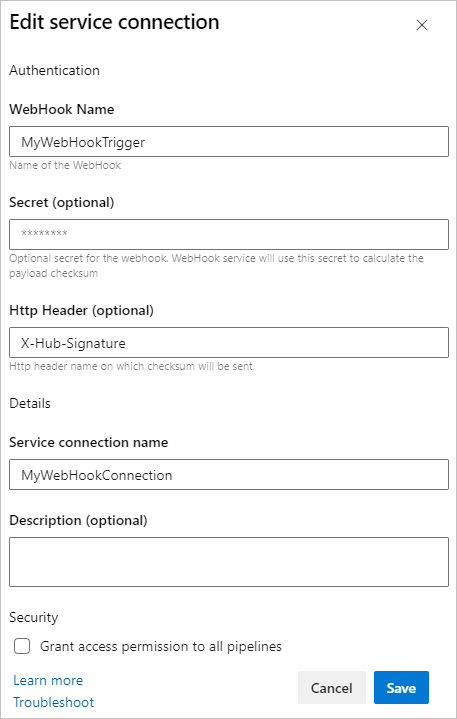
To trigger your pipeline using a webhook, you make a POST request to https://dev.azure.com/<org_name>/_apis/public/distributedtask/webhooks/<webhook_connection_name>?api-version=6.0-preview. This endpoint is publicly available and needs no authorization. The request should have a body similar to the following example:
{
"resource": {
"message": {
"title": "Hello, world!",
"subtitle": "I'm using WebHooks!"
}
}
}
Note
Accessing data from the webhook's request body can lead to incorrect YAML. For example, the pipeline step - script: echo ${{ parameters.WebHook.resource.message }} pulls in the entire JSON message, which generates invalid YAML. Any pipeline triggered via this webhook doesn't run, because the generated YAML is invalid.
Traceability
Azure Pipelines provides full traceability for any resource consumed at a pipeline or deployment job level. Azure Pipelines shows the following information for every pipeline run that uses resources:
- If a resource triggered the pipeline, the resource that triggered the pipeline.
- The resource versions and the artifacts consumed.
- Commits associated with each resource.
- Work items associated with each resource.
Associated CD pipeline information for CI pipelines
To provide end-to-end traceability, you can track which CD pipelines consumed a specific CI pipeline through the pipelines resource. If other pipelines consumed your CI pipeline, you see an Associated pipelines tab in the Run view. The view shows all the CD YAML pipeline runs that consumed your CI pipeline and the artifacts from it.
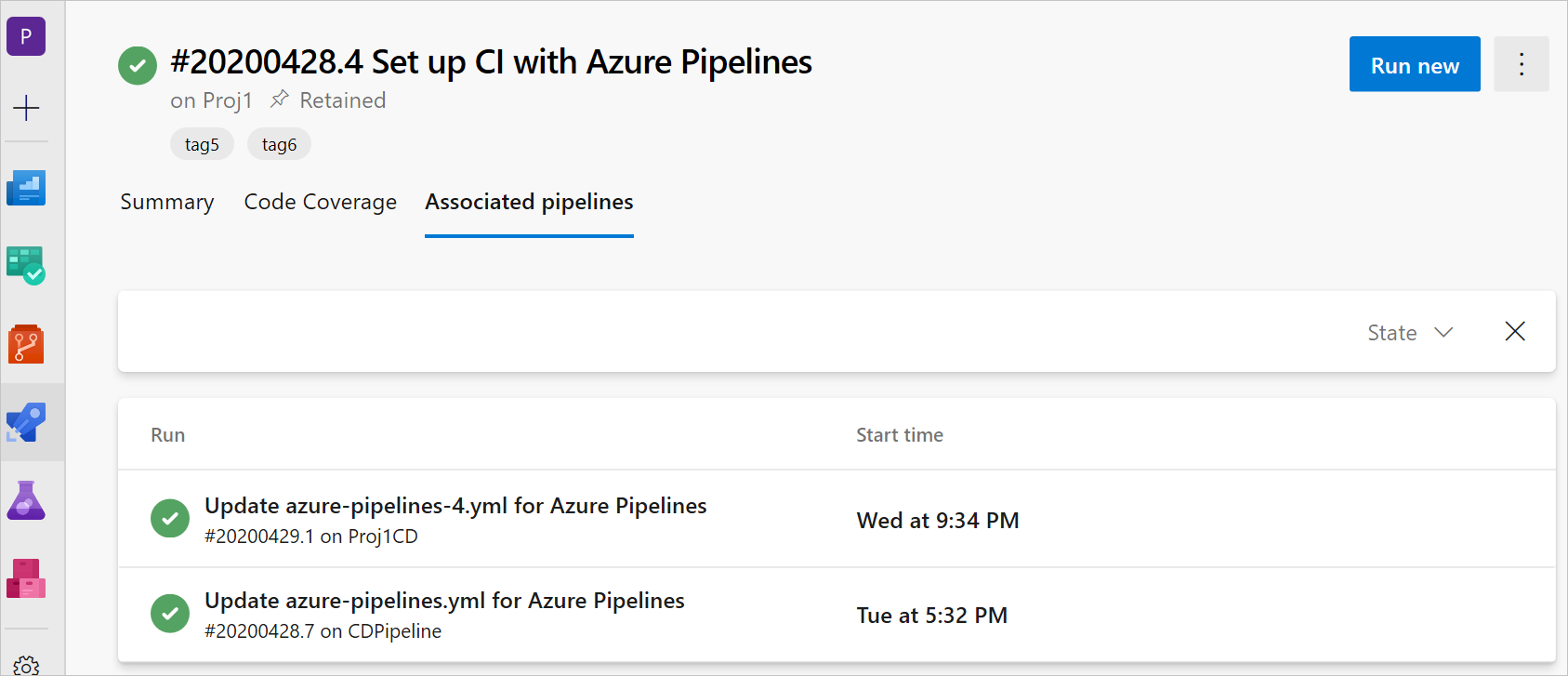
Environment traceability
After a pipeline deploys to an environment, you can see a list of resources that it consumed and their associated commits and work items.

FAQ
When should I use pipelines resources, the download shortcut, or the Download Pipeline Artifacts task?
Using a pipelines resource is a way to consume artifacts from a CI pipeline and also configure automated triggers. A resource gives you full visibility into the process by displaying the version consumed, artifacts, commits, and work items. When you define a pipeline resource, the associated artifacts are automatically downloaded in deployment jobs.
You can use the download shortcut to download the artifacts in build jobs or to override the download behavior in deployment jobs. For more information, see the steps.download definition.
The Download Pipeline Artifacts task doesn't provide traceability or triggers, but sometimes it makes sense to use this task directly. For example, you might have a script task stored in a different template that requires artifacts from a build to be downloaded. Or, you might not want to add a pipeline resource to a template. To avoid dependencies, you can use the Download Pipeline Artifacts task to pass all the build information to a task.
How can I trigger a pipeline run when my Docker Hub image gets updated?
The container resource trigger isn't available for Docker Hub for YAML pipelines, so you need to set up a classic release pipeline.
- Create a new Docker Hub service connection.
- Create a classic release pipeline and add a Docker Hub artifact. Set your service connection and select the namespace, repository, version, and source alias.
- Select the trigger and toggle the continuous deployment trigger to Enable. Every Docker push that occurs to the selected repository creates a release.
- Create a new stage and job. Add two tasks, Docker login and Bash.
- The Docker task has the
loginaction and signs you in to Docker Hub. - The Bash task runs
docker pull <hub-user>/<repo-name>[:<tag>].
- The Docker task has the
How can I validate and troubleshoot my webhook?
Create a service connection.
Reference your service connection and name your webhook in the
webhookssection.resources: webhooks: - webhook: MyWebhookTriggerAlias connection: MyServiceConnectionRun your pipeline. The webhook is created in Azure as a distributed task for your organization.
Perform a
POSTAPI call with valid JSON in the body tohttps://dev.azure.com/<organization>/_apis/public/distributedtask/webhooks/<webhook-name>?api-version=<apiversion>. If you receive a 200 status code response, your webhook is ready for consumption by your pipeline.
If you receive a 500 status code response with the error Cannot find webhook for the given webHookId ..., your code might be in a branch that's not your default branch. To address this issue:
- Select Edit on your pipeline page.
- From the More actions menu, select Triggers.
- Select the YAML tab and then select Get sources.
- Under Default branch for manual and scheduled builds, update your feature branch.
- Select Save & queue.
- After this pipeline runs successfully, perform a
POSTAPI call with valid JSON in the body tohttps://dev.azure.com/<organization>/_apis/public/distributedtask/webhooks/<webhook-name>?api-version=<apiversion>. You should now receive a 200 status code response.
Why didn't my resource trigger work?
Resource triggers can fail to execute because:
- The source of the provided service connection is invalid.
- The trigger isn't configured or there are syntax errors in the trigger.
- Trigger conditions aren't matched.
To see why pipeline triggers failed to execute, select the Trigger issues menu item on the pipeline definition page. Trigger issues isn't available for repository resources.
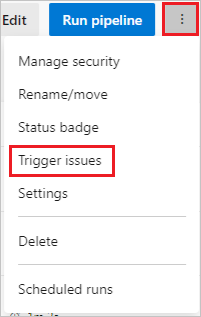
On the Trigger issues page, the error and warning messages describe why the trigger failed.
